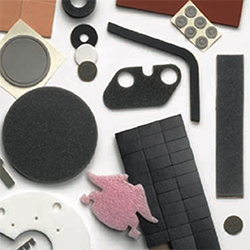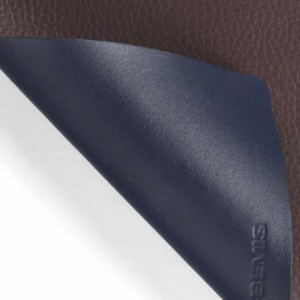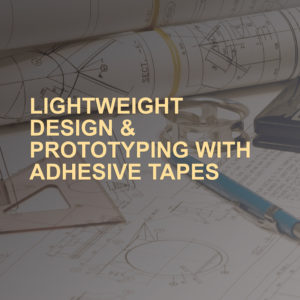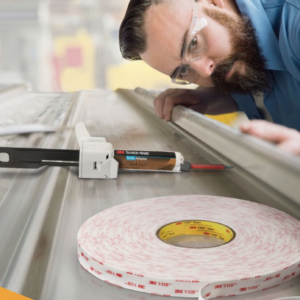How Tape Can Be Your Solution to Prototyping & Designing a Final Product
- How Tape can be Your Solution
- Questions during the Design and Engineering Stage
- Questions during the Concept Design
- Questions during the Implementation Stage
- Questions for the Manufacturing Team

How Tape can be Your Solution
In the world of competing objectives, how does an automotive manufacturer prioritize the 2012 US Government CAFE regulations calling for the increase of passenger and light-truck fuel efficiency? The mandated goal is for certain vehicles to achieve an average of 54.5 MPG by the year 2025. One strategy automotive companies are using to achieve this goal is called “lightweighting”. The objective is to source and use lighter-weight materials. Using custom adhesive tapes in place of other (read, heavier) fasteners and materials is an effective way to reduce the weight of the vehicle and therefore increase fuel efficiency
While the automotive industry is not the only industry concerned with reducing the weight of their products, it provides a good example for illustrating the ways in which the teams can work together to achieve this goal. While each team may have competing priorities, keeping the objective of weight reduction at the forefront will help focus the teams (Concept design, design and engineering, and manufacturing) to achieve the ultimate goal.
Questions during the Design and Engineering Stage
- Would an adhesive tape be useful to seal something?
- Would an adhesive tape be useful to bond one component to another?
- Would an adhesive tape be useful to communicate something? (i.e. Caution or Warning)
- Does this design need some type of film to act as surface protection?
- What is the nature of the surface you will be using the adhesive on?
- What is the anticipated condition/environment that the final product will be stored or used in?
- What are the cost constraints for this project?
Creating a lighter vehicle, or reducing the final weight of ANY product, requires all of the Production teams to work together from the very beginning. Let’s take a look at the function of each team and how adhesive tapes can be incorporated into their individual function to achieve the common objective of weight reduction.
Questions during the Concept Design
The role of the Concept Design Team is the creative force behind the final product. The Concept Design Team’s job is to “dream big” and anticipate the needs and desires of the consumer. Their questions might include:
- What features does the buyer care about?
- Does this vehicle model need to achieve certain things because of its price point, branding, or reputation?
- What will be the main factor motivating the customer to purchase this vehicle?
- Are qualities such as noise and passenger comfort at the forefront of this vehicle?
- Would an adhesive tape product achieve the goals of the brand or reputation of the vehicle?
Concept designers can specify adhesive tape products to contribute not only to the qualitative aspects (i.e. the look and feel of the product) but also to the weight objectives. For example, Very High Bond (VHB) Adhesive Tape can be used in place of rivets or screws to adhere emblems to the car body. Adhesive Foam tapes and sheets can be specified to cushion or muffle vibration noise to achieve a quieter cab. Adhesive tapes can be used to seal joints in the compartment to insulate the cab from outside noise, fumes, and weather. If a lighter weight vehicle is the objective, the Concept Design Team will also need to consider the weight of the additional features they are adding to the product and select the lightest weight, most effective bonding material to achieve their design objectives.
The specification set by Concept Design Team will affect how the other teams interpret and achieve the objective of creating a lighter weight vehicle.
Questions during the Implementation Stage
After the Concept Design team has completed its function, the Engineering and Design Team takes over to begin implementing the concept design. Their task is to interpret the design and make it ready for manufacturing. The Engineering and Design team develops and specifies the manufacturing methods, develops and specifies of the product, and identifies the manufacturing costs.
Questions this team may ask of the process are:
- Would an adhesive tape product be useful to provide heat shielding (for example aluminum foil tape heat shield, die cut to spec)?
- What are the conditions this product will be used or stored in? Is it likely this vehicle will be stored in a garage or outside?
- What joins and bonding can be achieved with a lighter-weight and more efficient adhesive bonding product, like an adhesive tape?
Throughout the entire process, the Engineering team’s objective is to ensure that every part of the design, especially bonded elements, works without failure and can withstand prolonged use. Both of these teams need to be on board with the common objective of lightweighting for it to make a difference in the final product.
Questions for the Manufacturing Team
Once the Design and Engineering teams are finished prototyping and testing the product, the project is handed off to the Manufacturing Team to begin production. The Manufacturing team handles everything from tooling, to coordinating with the supply chain, to final assembly. Their main objectives are to ensure the final costs are within budget and keep the production schedule on track.

- Would a converted adhesive tape product not only limit the weight of the product but also increase the efficiency and reduce the waste in the manufacturing process?
- What types of surfaces need to be bonded and what is the most effective method? For instance, will metal ever need to be bonded to rubber? Is there a lightweight adhesive tape solution available to achieve this?
Thinking carefully about the production process, it is possible to find quite a few areas where weight can be reduced by carefully substituting lighter weight materials that are equally effective as their heavier counterparts. In fact, an entire association has been created with this goal in mind. The priority of the Coalition for Automotive Lightweighting Materials, (CALM) is to “support the cost-effective integration of mixed materials to achieve significant reductions in mass through the collaborative efforts of the material sectors and the auto manufacturers.”
There are many options for lightweighting your product using custom adhesive tapes. Can-Do National Tape’s specialists are ready and able to help you with understanding the best specialty adhesives and coatings for your product and prototyping. Give us a call to see how we CAN convert your ideas into reality.


